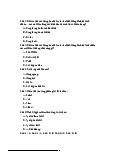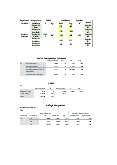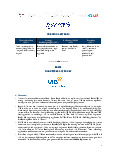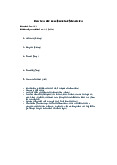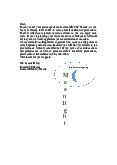








Preview text:
File C5-96 June 2013
www.extension.iastate.edu/agdm
Understanding the Time Value of Money
If I offered to give you $100, you would prob- represents fi ve years from today.
ably say yes. Then, if I asked you if you wanted Time Line
the $100 today or one year from today, you
would probably say today. This is a rational deci-
sion because you could spend the money now and
get the satisfaction from your purchase now rather 0 1 2 3 4 5
than waiting a year. Even if you decided to save the
money, you would rather receive it today because
Because money has a time value, it gives rise to the
you could deposit the money in a bank and earn
concept of interest. Interest can be thought of as rent
interest on it over the coming year. So there is a time
for the use of money. If you want to use my money value to money.
for a year, I will require that you pay me a fee for
the use of the money. The size of the rental rate or
Next, let’s discuss the size of the time value of mon-
user fee is the interest rate. If the interest rate is 10
ey. If I offered you $100 today or $105 dollars a year
percent, then the rental rate for using $100 for the
from now, which would you take? What if I offered year is $10.
you $110, $115, or $120 a year from today? Which
would you take? The time value of money is the Compounding
value at which you are indifferent to receiving the
Compounding is the impact of the time value of
money today or one year from today. If the amount
money (e.g., interest rate) over multiple periods into
is $115, then the time value of money over the com-
the future, where the interest is added to the original
ing year is $15. If the amount is $110, then the time
amount. For example, if you have $1,000 and invest
value is $10. In other words, if you will receive an
it at 10 percent per year for 20 years, its value after
additional $10 a year from today, you are indifferent
20 years is $6,727. This assumes that you leave the
to receiving the money today or a year from today.
interest amount earned each year with the invest-
ment rather than withdrawing it. If you remove the
When discussing the time value of money, it is
interest amount every year, at the end of 20 years
important to understand the concept of a time line.
the $1,000 will still be worth only $1,000. But if you
Time lines are used to identify when cash infl ows
leave it with the investment, the size of the invest-
and outfl ows will occur so that an accurate fi nancial
ment will grow exponentially. This is because you
assessment can be made. A time line is shown in the
are earning interest on your interest. This process is
next column with fi ve time periods. The time periods
called compounding. And, as the amount grows, the
may represent years, months, days, or any length of
size of the interest amount will also grow. As shown
time so long as each time period is the same length
in Table 1, during the fi rst year of a $1,000 invest-
of time. Let’s assume they represent years. The
ment, you will earn $100 of interest if the interest
zero tick mark represents today. The one tick mark
rate is 10 percent. When the $100 interest is added
represents a year from today. Any time during the
to the $1,000 investment it becomes $1,100 and 10
next 365 days is represented on the time line from
percent of $1,100 in year two is $110. This process
the zero tick mark to the one tick mark. At the one
continues until year 20, when the amount of interest
tick mark, a full year has been completed. When
is 10 percent of $6,116 or $611.60. The amount of
the second tick mark is reached, two full years have
the investment is $6,727 at the end of 20 years.
been completed, and it represents two years from
today. You can move on to the fi ve tick mark, which
The impact of compounding outlined in Table 1 is Don Hofstrand
retired extension agriculture specialist agdm@iastate.edu Page 2 File C5-96
shown graphically in Figure 1. The increase in the
Table 1. Compounding computation of $1,000
size of the cash amount over the 20-year period does over 20 years at an annual interest rate of 10
not increase in a straight line but rather exponen- percent.
tially. Because the slope of the line increases over Year Amount Computation
time it means that each year the size of the increase
is greater than the previous year. If the time period 0 $1,000
is extended to 30 or 40 years, the slope of the line 1
$1,100 $1,000 x 10% = $100 + $1,000 = $1,100
would continue to increase. Over the long-term, 2
$1,210 $1,100 x 10% = $110 + $1,100 = $1,210
compounding is a very powerful fi nancial concept. 3
$1,331 $1,210 x 10% = $121 + $1,210 = $1,331 4
$1,464 $1,331 x 10% = $133 + $1,331 = $1,464
The effect of compounding is also greatly impacted 5
$1,611 $1,464 x 10% = $146 + $1,464 = $1,611
by the size of the interest rate. Essentially, the larger 6
$1,772 $1,611 x 10% = $161 + $1,611 = $1,772
the interest rate the greater the impact of compound-
ing. In addition to the compounding impact of a 10 7
$1,949 $1,772 x 10% = $177 + $1,772 = $1,949
percent interest rate, Figure 2 shows the impact of 8
$2,144 $1,949 x 10% = $195 + $1,949 = $2,144
a 15 percent interest rate (5 percent higher rate) and 9
$2,358 $2,144 x 10% = $214 + $2,144 = $2,358
5 percent (5 percent lower rate). Over the 20-year 10
$2,594 $2,358 x 10% = $236 + $2,358 = $2,594
period, the 15 percent rate yields almost $10,000 11
$2,853 $2,594 x 10% = $259 + $2,594 = $2,853
more than the 10 percent rate, while the 5 percent 12
$3,138 $2,853 x 10% = $285 + $2,853 = $3,138
rate results in about $4,000 less. By examining the 13
$3,452 $3,138 x 10% = $314 + $3,138 = $3,452
last 10 years of the 20-year period you can see that
increasing the number of time periods and the size 14
$3,797 $3,452 x 10% = $345 + $3,452 = $3,797
of the interest rate greatly increases the power of 15
$4,177 $3,797 x 10% = $380 + $3,797 = $4,177 compounding. 16
$4,959 $4,177 x 10% = $418 + $4,177 = $4,595 17
$5,054 $4,595 x 10% = $456 + $4,595 = $5,054 18
$5,560 $5,054 x 10% = $505 + $5,054 = $5,560 19
$6,116 $5,560 x 10% = $556 + $5,560 = $6,116 20
$6,727 $6,116 x 10% = $612 + $6,116 = $6,727 File C5-96 Page 3
Table 2 shows the same compounding impact as Table
Table 2. Compounding computation of
1 but with a different computational process. An easier
$1,000 over 20 years at an annual interest
way to compute the amount of compound interest is to rate of 10 percent.
multiply the investment by one plus the interest rate. Year Amount Computation
Multiplying by one maintains the cash amount at its 0 $1,000
current level and .10 adds the interest amount to the 1 $1,100 $1,000 x 1.10 = $1,100
original cash amount. For example, multiplying $1,000 2 $1,210 $1,100 x 1.10 = $1,210
by 1.10 yields $1,100 at the end of the year, which is
the $1,000 original amount plus the interest amount of 3 $1,331 $1,210 x 1.10 = $1,331 $100 ($1,000 x .10 = $100). 4 $1,464 $1,331 x 1.10 = $1,464 5 $1,611 $1,464 x 1.10 = $1,611
Another dimension of the impact of compounding is 6 $1,772 $1,611 x 1.10 = $1,772
the number of compounding periods within a year. 7 $1,949 $1,772 x 1.10 = $1,949
Table 3 shows the impact of 10 percent annual com- 8 $2,144 $1,949 x 1.10 = $2,144
pounding of $1,000 over 10 years. It also shows the 9 $2,358 $2,144 x 1.10 = $2,358
same $1,000 compounded semiannually over the 10 $2,594 $2,358 x 1.10 = $2,594
10-year period. Semiannual compounding means a 10
percent annual interest rate is converted to a 5 per- 11 $2,853 $2,594 x 1.10 = $2,853
cent interest rate and charged for half of the year. The 12 $3,138 $2,853 x 1.10 = $3,138
interest amount is then added to the original amount, 13 $3,452 $3,138 x 1.10 = $3,452
and the interest during the last half of the year is 5 14 $3,797 $3,452 x 1.10 = $3,797
percent of this larger amount. As shown in Table 15 $4,177 $3,797 x 1.10 = $4,177
3, semiannual compounding will result in 20 com- 16 $4,595 $4,177 x 1.10 = $4,595
pounding periods over a 10-year period, while annual
compounding results in only 10 compounding period. 17 $5,054 $4,595 x 1.10 = $5,054
A shorter compounding period means a larger number 18 $5,560 $5,054 x 1.10 = $5,560
of compounding periods over a given time period and 19 $6,116 $5,560 x 1.10 = $6,116 20 $6,727 $6,116 x 1.10 = $6,727 Page 4 File C5-96
Table 3. A comparison of $1,000 compounding annually versus semiannually (20 years, 10 percent interest) Compounding Annually
Compounding Semiannually Year Amount Computation Amount Computation 0 $1,000 $1,000 0.5 $1,050 $1,000 x 1.05 = $1,050 1 $1,100 $1,000 x 1.10 = $1,100 $1,103 $1,050 x 1.05 = $1,103 1.5 $1,158 $1,103 x 1.05 = $1,158 2 $1,210 $1,100 x 1.10 = $1,210 $1,216 $1,158 x 1.05 = $1,216 2.5 $1,276 $1,216 x 1.05 = $1,276 3 $1,331 $1,210 x 1.10 = $1,331 $1,340 $1,276 x 1.05 = $1,340 3.5 $1,407 $1,276 x 1.05 = $1,407 4 $1,464 $1,331 x 1.10 = $1,464 $1,477 $1,407 x 1.05 = $1,477 4.5 $1,551 $1,477 x 1.05 = $1,551 5 $1,611 $1,464 x 1.10 = $1,611 $1,629 $1,551 x 1.05 = $1,629 5.5 $1,710 $1,629 x 1.05 = $1,710 6 $1,772 $1,611 x 1.10 = $1,772 $1,796 $1,710 x 1.05 = $1,796 6.5 $1,886 $1,710 x 1.05 = $1,886 7 $1,949 $1,772 x 1.10 = $1,949 $1,980 $1,886 x 1.05 = $1,980 7.5 $2,079 $1,980 x 1.05 = $2,079 8 $2,144 $1,949 x 1.10 = $2,144 $2,183 $2,079 x 1.05 = $2,183 8.5 $2,292 $2,183 x 1.05 = $2,292 9 $2,358 $2,144 x 1.10 = $2,358 $2,407 $2,292 x 1.05 = $2,407 9.5 $2,527 $2,407 x 1.05 = $2,527 10 $2,594 $2,358 x 1.10 = $2,594 $2,653 $2,527 x 1.05 = $2,653
a greater compounding impact. If the compounding
the important fact to remember is that discounting
period is shortened to monthly or daily periods, the
is the opposite of compounding. As shown below, if
compounding impact will be even greater.
we start with a future value of $6,727 at the end of
20 years in the future and discount it back to today Discounting
at an interest rate of 10 percent, the present value is
Although the concept of compounding is straight $1,000
forward and relatively easy to understand, the
concept of discounting is more diffi cult. However, File C5-96 Page 5
As shown in Table 2, the compounding factor of an-
Table 4. Discounting computation of $6,727
nually compounding at an interest rate of 10 percent
over 20 years at an annual discount rate of
is 1.10 or 1.10/1.00. If discounting is the opposite of 10 percent.
compounding, then the discounting factor is 1.00 / Year Amount Computation
1.10 = .90909 or .91. As shown in Table 4, the dis- 20 $6,727
counted amount becomes smaller as the time period 19 $6,116 $6,727 x .91 = $6,116
moves closer to the current time period. When we 18 $5,560 $6,115 x .91 = $5,560
compounded $1,000 over 20 years at a 10 percent 17 $5,054 $5,560 x .91 = $5,054
interest rate, the value at the end of the period is
$6,727 (Table 2). When we discount $6,727 over 20 16 $4,595 $5,054 x .91 = $4,595
years at a 10 percent interest rate, the present value 15 $4,177 $4,595 x .91 = $4,177 or value today is $1,000. 14 $3,797 $4,117 x .91 = $3,797 13 $3,452 $3,797 x .91 = $3,452
The discounting impact is shown in Figure 3. Note 12 $3,138 $3,452 x .91 = $3,138
that the curve is the opposite of the compounding 11 $2,853 $3,138 x .91 = $2,853 curve in Figure 1. 10 $2,594 $2,853 x .91 = $2,594
The impact of discounting using interest rates of 5 9 $2,358 $2,594 x .91 = $2,358
percent, 10 percent, and 15 percent is shown in Fig- 8 $2,144 $2,358 x .91 = $2,144
ure 4. The 15 percent interest rate results in a larger 7 $1,949 $2,144 x .91 = $1,949
discounting impact than the 10 percent rate, just as 6 $1,772 $1,949 x .91 = $1,772
the 15 percent interest rate results in a larger com- 5 $1,611 $1,772 x .91 = $1,611
pounding impact as shown in Figure 2. 4 $1,464 $1,661 x .91 = $1,464 3 $1,331 $1,464 x .91 = $1,331 2 $1,210 $1,331 x .91 = $1,210 1 $1,100 $1,210 x .91 = $1,100 0 $1,000 $1,100 x .91 = $1,000 Page 6 File C5-96 Discounting Example
words, the bond will yield $10,000 at maturity,
An example of discounting is to determine the pres-
which is received at the end of 10 years. The bond
ent value of a bond. A bond provides a future stream
also has an annual annuity (an annuity is a stream
of income. It provides a cash return at a future time
of equal cash payments at regular time intervals for
period, often called the value at maturity. It may
a fi xed period of time) equity to 10 percent of the
also provide a stream of annual cash fl ows until the
value at maturity. So, the bond yields 10 $1,000
maturity of the bond. Table 5 shows an example of
(10% x $10,000) annual payments over the 10-year
a $10,000 bond with a 10-year maturity. In other
period. Adding together the 10 $1,000 payments plus
the $10,000 value at maturity, the future cash return
Table 5. 10-year bond with 10 percent from the bond is $20,000.
annual annuity and $10,000 payout at the end of 10 years.
To compute the current value of the bond, we must Value at
discount the future cash fl ows back to the time when Year Annuity Total Maturity
the bond is purchased. To do this we must select 0
an interest rate (called the discount rate when we 1 $1,000 $1,000
are discounting). In Table 6, we have calculated 2 $1,000 $1,000
the present value of the bond using discount rates
of 5 percent, 10 percent, and 15 percent. First, let’s 3 $1,000 $1,000
examine the computation using a 5 percent rate. 4 $1,000 $1,000
Each of the $1,000 annuity payments is discounted 5 $1,000 $1,000
to the present value. Note that the one year $1,000 6 $1,000 $1,000
annuity payment has a present value of $952 and the 7 $1,000 $1,000
10-year payment has a present value of $614. This 8 $1,000 $1,000
is because the fi rst-year payment is only discounted 9 $1,000 $1,000
one time and the tenth-year payment is discounted
10 times over 10 years. The present value of all 10 10 $1,000 $10,000 $11,000
annuity payments is $7,722. The present value of the Total $10,000 $10,000 $20,000 File C5-96 Page 7
Discount Rate = 10 Percent
$10,000 at maturity (after 10 years) is $6,139. Note Value at
that the present value of the $10,000 of annual an- Year Annuity Total Maturity
nuity payments is greater than the $10,000 payment 0
received at maturity because most of the annuity 1 $909 $909
payments are discounted over time periods less than 2 $826 $826
10 years. The total present value of the annuity and 3 $751 $751
the value at maturity is $13,861. So, the $20,000 4 $683 $683
of future cash payments has a value at the time of
purchase of $13,861. Looking at it from a differ- 5 $621 $621
ent perspective, if you paid $13,861 for this bond 6 $564 $564
you would receive a 5 percent annual rate of return 7 $513 $513
(called the internal rate of return) over the 10-year 8 $467 $467 period. 9 $424 $424 10 $386 $3,855 $4,241 Total $6,145 $3,855 $10,000
Table 6. Computing the Present Value of
the Bond Shown in Table 5.
If we increase the discount rate to 15 percent, the
Discount Rate = 5 Percent
discounting power becomes even greater. The pres- Value at
ent value of the bond drops to $7,491. In other words, Year Annuity Total Maturity
if you want a 15 percent rate of return you can only 0
pay $7,491 for the bond that will generate $20,000 in 1 $952 $952
future cash payments. Note that the value at maturity 2 $907 $907
dropped from $6,139 (5 percent) to $3,855 (10 per- 3 $864 $864
cent) to $2,472 (15 percent). The value of the annuity 4 $823 $823
dropped in smaller increments from $7,722 (5 percent) 5 $784 $784
to $6,145 (10 percent) to $5,019 (15 percent). 6 $746 $746
Discount Rate = 15 Percent 7 $711 $711 Value at Year Annuity Total 8 $677 $677 Maturity 9 $645 $645 0 10 $614 $6,139 $6,753 1 $870 $870 Total $7,722 $6,139 $13,861 2 $756 $756 3 $658 $658
If we increase the discount rate from 5 percent to 4 $572 $572
10 percent, the discounting power becomes greater. 5 $497 $497
The present value of the bond drops from $13,861 6 $432 $432
to $10,000. In other words, if you want a 10 percent 7 $376 $376
rate of return you can only pay $10,000 for the bond 8 $327 $327
that will generate $20,000 in future cash payments. 9 $284 $284
Note that the value at maturity dropped over $2,000 10 $247 $2,472 $2,719
from $6,139 to $3,855. Conversely, the value of the Total $5,019 $2,472 $7,491
annuity dropped from $7,722 to $6,145, a reduction of about $1,600.
A bond is a simple example of computing the present
value of an asset with an annual cash income stream
and a terminal value at the end of the time period. This
methodology can be used to analyze any investment
that has an annual cash payment and a terminal or
salvage value at the end of the time period. Page 8 File C5-96 Perpetuity
“PV” multiplied by one plus the interest rate to the
A perpetuity is similar to an annuity except that an
power of the number of compounding periods. We
annuity has a limited life and a perpetuity is an even
are solving for the future compounded value (FV), in
payment that has an unlimited life. The computa-
which the present value (PV) is $1,000, the annual
tion of a perpetuity is straight forward. The present
interest rate (Rate) is 10 percent, and the number
value of a perpetuity is the payment divided by the
of time periods (Nper) is 20 years. This results in discount rate.
$1,000 multiplied by 6.727 and a future value of
$6,727. Note that this is the same result as shown in
Present Value = Perpetuity Payment Tables 1 and 2. Discount Rate FV = PV (1 + Rate) Nper Payment = $10,000 FV = $1,000 (1 + .10) 20 Discount Rate = 10 percent Present Value = ? FV = $1,000 x 1.10 20 FV = $1,000 x 6.727 $10,000 = $100,000 10% FV = $6,727
Time Value of Money Formulas
To compute the discounted value of an amount of
money to be received in the future, we use the same
There are mathematical formulas for compounding
formula but solve for the present value rather than
and discounting that simplify the methodology. At
the future value. To adjust our formula, we divided
right are the formulas, in which:
both sides by (1 + Rate) Nper and the following for- mula emerges. •
“PV” represents the present value at the begin- ning of the time period. PV = FV •
“FV” represents the future value at the end of (1 + Rate) Nper the time period. •
“N” or “Nper” represents the number of com- PV = $6,727 (1 + .10) 20
pounding or discounting periods. It can represent
a specifi c number of years, months, days, or PV = $6,727
other predetermined time periods. 1.10 20 •
“Rate” or “i” represents the interest rate for PV = $6,727
the time period specifi ed. For example, if “N” 6.727
represents a specifi ed number of years, then the PV = $1,000
interest rate represents an annual interest rate. If
“N” represents a specifi c number of days, then
The present value (PV) of a future value (FV) of
the interest rate represents a daily interest rate.
$6,727 discounted over 20 years (Npers) at an an-
nual discount interest rate (Rate) of 10 percent is
If we are computing the compounded value of a
$1,000, the same as shown in Table 4.
current amount of money into the future, we will use
the following formula. The future value “FV” that
we are solving for is the current amount of money File C5-96 Page 9
Time Value of Money Computation
If an annuity is involved, you can use the payment
A fi nancial calculator or an electronic spreadsheet on
function (PMT). In the example below, the present
a personal computer is a useful tool for making time
value is $10,000, the same as the present value of the
value of money computations. For compounding bond example in Table 6.
computations, you enter the present value, interest
rate, and the number of time periods, and the calcu- Future Value (FV) = $10,000
lator or personal computer will compute the future
Discount Interest Rate (Rate) = 10 percent
value. The future value for the example below is Time Period (Nper) = 10 years
$6,727, the same as the future value shown in Tables Annuity (PMT) = $1,000 Present Value (PV) = ? 1 and 2. Present Value (PV) = $1,000
By using a fi nancial calculator or personal computer,
Interest Rate (Rate) = 10 percent
you can compute any of the values in the examples
Number of Periods (Nper) = 20 years
above as long as you know the other values. For Future Value (FV) = ?
example, you can compute the interest rate if you
know the future value, present value, and number of
Likewise, for discounting computations you enter
time periods. You can compute the number of time
the future value, interest rate, and the number of time
periods if you know the present value, future value,
periods, and the calculator or personal computer will
and interest rate. The same is true if an annuity is
compute the present value. The present value for the involved.
example below is $1,000, the same as the present value shown in Table 4. Future Value (FV) = $6,727
Discount Rate (Rate) = 10 percent Time Period (Nper) = 20 years Present Value (PV) = ? . . . and justice for all
The U.S. Department of Agriculture (USDA) prohibits discrimination in all its programs and ac-
Issued in furtherance of Cooperative Extension work, Acts of May 8 and November 30, 1914,
tivities on the basis of race, color, national origin, gender, religion, age, disability, political beliefs,
in cooperation with the U.S. Department of Agriculture. Cathann A. Kress, director, Cooperative
sexual orientation, and marital or family status. (Not all prohibited bases apply to all programs.)
Extension Service, Iowa State University of Science and Technology, Ames, Iowa.
Many materials can be made available in alternative formats for ADA clients. To fi le a complaint
of discrimination, write USDA, Offi ce of Civil Rights, Room 326-W, Whitten Building, 14th and
Independence Avenue, SW, Washington, DC 20250-9410 or call 202-720-5964.
